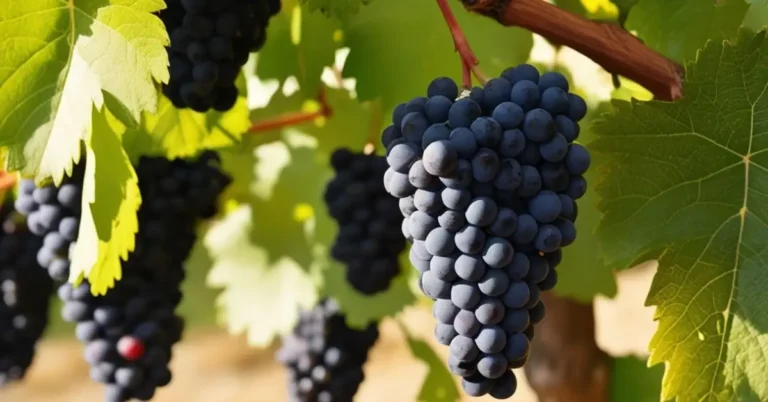The Lacrima grape, a rare and ancient varietal from Italy, captivates wine enthusiasts with its distinct aroma, historical roots, and flavorful wines. Found mainly in the Marche region, Lacrima is more than just a grape—it’s a story of survival, tradition, and the artistry of Italian viticulture.
A Brief History of Lacrima
Lacrima’s origins trace back centuries, predominantly to the Marche region, particularly around Morro d’Alba. Its name, meaning “tear” in Italian, derives from the unique teardrop-like juice droplets that emerge from its ripe berries. Despite its noble reputation in ancient times, Lacrima faced near extinction due to limited cultivation and competition from more popular varietals. Fortunately, efforts in the 1980s revitalized the grape, securing its place in Italian winemaking traditions.
What Makes Lacrima Unique?
Physical Characteristics
- Berries: Lacrima grapes are medium-sized, spherical, and deep blue-black in color, with firm skins that produce aromatic juice.
- Clusters: The grape bunches are loosely packed, pyramid-shaped, and known for their moderate yield.
- Leaves: Pentagonal and five-lobed, typical of traditional Italian grape varieties.
These characteristics make Lacrima visually distinct and integral to its winemaking attributes.
Flavor Profile
Lacrima grapes produce wines celebrated for their aromatic complexity. Expect:
- Aroma: Floral scents like violet and rose, complemented by fruity notes such as cherry and raspberry.
- Taste: Medium to full-bodied with balanced acidity, offering a smooth and fruity palate.
- Color: Ruby red with purple hues, showcasing elegance and depth.
This unique profile makes Lacrima wines versatile, appealing to both casual drinkers and seasoned sommeliers.
Regions Where Lacrima Thrives
Although most famously cultivated in Morro d’Alba in Marche, small-scale production also occurs in regions like Tuscany, Romagna, and Apulia. The grape thrives in specific climates, favoring warm, temperate conditions. However, its sensitivity to pests and diseases requires meticulous care from growers.
Lacrima Wine: The Star of Marche
The most iconic expression of Lacrima is found in the wines under the Lacrima di Morro d’Alba DOC designation. These wines are subject to strict production rules to ensure quality, including limitations on yield and geographic origin.
Other notable appellations include:
- Colli Maceratesi DOC: A blend that highlights Lacrima’s fruit-forward nature.
- Salento IGT: Unique expressions of Lacrima from southern Italy.
How Does Lacrima Compare to Other Grapes?
| Aspect | Lacrima | Sangiovese | Barbera |
|---|---|---|---|
| Primary Region | Marche | Tuscany | Piedmont |
| Aroma | Floral, fruity | Cherry, earthy | Bright, tangy |
| Body | Medium to full-bodied | Medium | Light to medium |
| Acidity | Balanced | High | High |
| Aging Potential | Medium | High | Moderate |
Lacrima stands out for its aromatic elegance, making it a great alternative for those exploring Italy’s less mainstream grapes.
Cultivation Challenges
Lacrima is not the easiest grape to grow. Its susceptibility to rot and pests demands rigorous attention. Additionally, climatic variations can significantly impact yield and quality. However, its high vigor and potential for unique flavors make it a rewarding challenge for winemakers.
Pairing Lacrima Wines with Food
Lacrima wines’ fruity and floral profile pairs beautifully with:
- Cuisine:
- Grilled meats like lamb or pork.
- Creamy risottos with mushroom or truffle.
- Aged cheeses, particularly Pecorino or Asiago.
- Occasions:
- Romantic dinners, as the wine’s floral notes add a touch of elegance.
- Celebratory meals, given its balance of complexity and approachability.
Insights into Winemaking
The winemaking process for Lacrima focuses on preserving its aromatic qualities. Techniques such as controlled fermentation and careful aging in steel or oak barrels enhance its natural flavors. Producers often experiment with blends, incorporating other varietals to create unique expressions.
Why Lacrima Deserves More Recognition
Despite its limited cultivation, Lacrima has carved a niche among Italy’s native grapes. Its distinctive flavor profile and aromatic richness make it a hidden gem in the world of wine. For those seeking a break from conventional varietals like Merlot or Pinot Noir, Lacrima offers a refreshing and memorable experience.
Video Spotlight
For a closer look at Lacrima’s cultivation and winemaking, explore this informative video: Watch Here.
Lacrima is more than just a grape; it’s a testament to the resilience of Italian winemaking traditions. Its elegance, versatility, and rich history make it a must-try for any wine enthusiast. Next time you’re exploring Italian wines, let Lacrima’s “tears” grace your glass and your palate.

